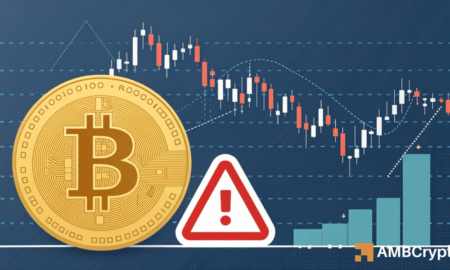Bitcoin Market Sentiment: A Shift from Greed to Caution
The current state of the Bitcoin (BTC) market reflects a significant shift in sentiment, moving from an optimistic "greed" phase to a more cautious climate characterized by fear among short-term holders (STHs). Bitcoin has recently experienced a decline, dropping approximately 8% from its all-time high (ATH) of $117,000. This situation raises questions about the longevity of the rally that propelled BTC prices earlier this month and whether it may signify the onset of a more pronounced correction.
Recent Trends and Market Response
On August 16, Bitcoin’s price peaked at $117,000 but faced strong resistance, leading to a subsequent three-day streak of net outflows from the market. As a result, the price fell to around $112,000. This downturn illustrates a concerning trend where bid-side liquidity—essentially the number of buy orders in the market—began to dwindle. This lack of buying support is critical as it sets the stage for potential sell-offs, particularly among short-term traders looking to limit their losses. During this period, STHs saw their Selling, General, and Administrative Expenses (SOPR) drop below 1 for the first time in two weeks, indicating that these holders were selling their assets at a loss more significantly than seen in the preceding month.
Understanding SOPR and Market Dynamics
The SOPR metric is a valuable indicator for gauging market sentiment among short-term traders. When the SOPR dips below 1, it signals capitulation; that is, sellers are letting go of their Bitcoin below the price they initially paid. In this current scenario, many traders who purchased BTC during its recent high of $117,000 are now offloading their coins to break even, contributing to increased selling pressure. This has resulted in a situation where bullish sentiments among traders have weakened, leaving the market vulnerable to further price declines. Indeed, the breakdown in bid-side liquidity presents a critical moment for Bitcoin’s price stability, particularly when the market appears susceptible to significant bearish actions.
Key Levels to Watch
As of now, Bitcoin is at a pivotal inflection point. It is hovering around early August support levels, which traders are keenly watching for signs of strength or weakness. A robust bid wall at this level could potentially flip the market sentiment to bullish, possibly squeezing out late shorts who have not yet closed their positions. Conversely, if bid-side liquidity remains weak, a repeat of the $117,000 resistance scenario could occur, dramatically affecting price direction. The current bod/ask ratio and slippage also indicate potential susceptibility to sharp price movements, depending significantly on market activity from retail traders, who currently have a relatively high long position.
Caution Ahead: Risks of Overexposure
The heightened retail trading sentiment—currently stacked at around 61–62% expressing bullish positions—adds another layer of complexity to the ongoing market scenario. While small traders might expect a rebound, their overweight positions might become problematic if the market shifts negatively. Specifically, a lack of fresh buying activity could contribute to marginal movements lower, pushing Bitcoin down through crucial support levels. Additionally, a breakdown below the $110,000 zone cannot be ruled out, further intensifying bearish speculation among market participants.
A Muted Rally in Focus
Overall, the interplay of retail overexposure and thin liquidity poses a risk to any potential rallies. While there is a chance for brief upward movements, the current market setup indicates that such rallies would likely be muted without fresh buy-side momentum. Thus, traders should proceed with caution as they navigate these uncertain waters. A closer eye should also be kept on the macroeconomic factors and news developments that could affect market liquidity and sentiment.
In conclusion, Bitcoin is currently caught in a challenging inflection zone, with STHs capitulating and market dynamics becoming increasingly fragile. As the landscape changes rapidly, investors and traders alike must remain cautious and continually assess the evolving conditions that may impact BTC’s performance in the near future. Observing market liquidity, trading volumes, and associated sentiment can provide crucial insights into the potential trajectories for Bitcoin, making it imperative that participants stay informed and vigilant as they navigate this complex environment.
















